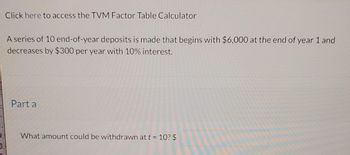
ENGR.ECONOMIC ANALYSIS
14th Edition
ISBN: 9780190931919
Author: NEWNAN
Publisher: Oxford University Press
expand_more
expand_more
format_list_bulleted
Question

Transcribed Image Text:D.
Click here to access the TVM Factor Table Calculator
A series of 10 end-of-year deposits is made that begins with $6,000 at the end of year 1 and
decreases by $300 per year with 10% interest.
Part a
What amount could be withdrawn at t = 10? $
Expert Solution
This question has been solved!
Explore an expertly crafted, step-by-step solution for a thorough understanding of key concepts.
This is a popular solution
Trending nowThis is a popular solution!
Step by stepSolved in 2 steps

Knowledge Booster
Learn more about
Need a deep-dive on the concept behind this application? Look no further. Learn more about this topic, economics and related others by exploring similar questions and additional content below.Similar questions
- Elmo borrowed S30,000 from the Statler & Waldorf Bank at 12% APR, compounded monthly. The loan is to be repaid in equal monthly payments over a 5-year period. (No statements required for this question. Just find the numbers asked for) a. What is the monthly loan payment amount?arrow_forwardCompute the effective annual rate of interest (a) for 6% compounded monthly; (b) at which $1100 will grow to $2000 in seven years compounded monthly. Please write to text formet answerarrow_forwardFind the periodic payments PMT necessary to accumulate the given amount in an annuity account. (Assume end-of-period deposits and compounding at the same intervals as deposits. Round your answer to the nearest cent.) $80,000 in a fund paying 3% per year, with monthly payments for 10 years PMT = $ Need Help? Watch It Read Itarrow_forward
- You borrow $6,000 for 90 days at 6.5% interest. The lender uses a 365-day year. You make a payment of $1,400 on day 36 (36 days after getting the loan). Calculate your balance after the $1,400 payment is applied.arrow_forwardEmily wants to save part of her salary for a new car in a savings account that earns 8% annual interest. At the end of the first year, she saves $1000 and increases her savings by $500 each year until she buys the car at the end of year 6. How much would be accumulated in her account at the end of year 6? Round to the nearest dollar.arrow_forwardThe balance of an account continuously compounded was $2006 after 7 years and $6790 after 12 years. What's the balance after 14 years? dollars.arrow_forward
- What equal amount (Q) must be deposited at the beginning of each year for the next 5 year s in a saving account with 10% interest in order to get a future sum of $1000 at the end of year 6. Please provide me a cash flow diagram and calculate.arrow_forwardAn executive invested 1M to an account that earns 8% compounded continuously. Determine the amount of his money at the end of 20 years.arrow_forwardFind the amount accumulated FV in the given annuity account. HINT [See Quick Example 1 and Example 1.] (Assume end-of-period deposits and compounding at the same intervals as deposits. Round your answer to the nearest cent.) $110 deposited monthly for 20 years at 3% per year in an account containing $12,000 at the start $ Need Help? Master It Read Itarrow_forward
- K How much money should be deposited annually in a bank account for five years if you wish to withdraw $6,000 each year for three years, beginning five years after the last deposit? The interest rate is 2% per year. Click the icon to view the interest and annuity table for discrete compounding when i=2% per year. The annual deposit amount should equal $ per year. (Round to the nearest dollar.)arrow_forwardIn an account earning 8% nominal interest compounded bimonthly. How much should be deposited now to accumulate $9052 after 13 years? Select onoarrow_forwardFind the amount accumulated FV in the given annuity account. HINT [See Quick Example 1 and Example 1.] (Assume end-of-period deposits and compounding at the same intervals as deposits. Round your answer to the nearest cent.) $150 is deposited monthly for 11 years at 2% per year FV = $ Need Help? Read It Submit Answerarrow_forward
arrow_back_ios
SEE MORE QUESTIONS
arrow_forward_ios
Recommended textbooks for you

 Principles of Economics (12th Edition)EconomicsISBN:9780134078779Author:Karl E. Case, Ray C. Fair, Sharon E. OsterPublisher:PEARSON
Principles of Economics (12th Edition)EconomicsISBN:9780134078779Author:Karl E. Case, Ray C. Fair, Sharon E. OsterPublisher:PEARSON Engineering Economy (17th Edition)EconomicsISBN:9780134870069Author:William G. Sullivan, Elin M. Wicks, C. Patrick KoellingPublisher:PEARSON
Engineering Economy (17th Edition)EconomicsISBN:9780134870069Author:William G. Sullivan, Elin M. Wicks, C. Patrick KoellingPublisher:PEARSON Principles of Economics (MindTap Course List)EconomicsISBN:9781305585126Author:N. Gregory MankiwPublisher:Cengage Learning
Principles of Economics (MindTap Course List)EconomicsISBN:9781305585126Author:N. Gregory MankiwPublisher:Cengage Learning Managerial Economics: A Problem Solving ApproachEconomicsISBN:9781337106665Author:Luke M. Froeb, Brian T. McCann, Michael R. Ward, Mike ShorPublisher:Cengage Learning
Managerial Economics: A Problem Solving ApproachEconomicsISBN:9781337106665Author:Luke M. Froeb, Brian T. McCann, Michael R. Ward, Mike ShorPublisher:Cengage Learning Managerial Economics & Business Strategy (Mcgraw-...EconomicsISBN:9781259290619Author:Michael Baye, Jeff PrincePublisher:McGraw-Hill Education
Managerial Economics & Business Strategy (Mcgraw-...EconomicsISBN:9781259290619Author:Michael Baye, Jeff PrincePublisher:McGraw-Hill Education


Principles of Economics (12th Edition)
Economics
ISBN:9780134078779
Author:Karl E. Case, Ray C. Fair, Sharon E. Oster
Publisher:PEARSON

Engineering Economy (17th Edition)
Economics
ISBN:9780134870069
Author:William G. Sullivan, Elin M. Wicks, C. Patrick Koelling
Publisher:PEARSON

Principles of Economics (MindTap Course List)
Economics
ISBN:9781305585126
Author:N. Gregory Mankiw
Publisher:Cengage Learning

Managerial Economics: A Problem Solving Approach
Economics
ISBN:9781337106665
Author:Luke M. Froeb, Brian T. McCann, Michael R. Ward, Mike Shor
Publisher:Cengage Learning

Managerial Economics & Business Strategy (Mcgraw-...
Economics
ISBN:9781259290619
Author:Michael Baye, Jeff Prince
Publisher:McGraw-Hill Education